The AMD Radeon R9 290X Review
by Ryan Smith on October 24, 2013 12:01 AM EST- Posted in
- GPUs
- AMD
- Radeon
- Hawaii
- Radeon 200
XDMA: Improving Crossfire
Over the past year or so a lot of noise has been made over AMD’s Crossfire scaling capabilities, and for good reason. With the evolution of frame capture tools such as FCAT it finally became possible to easily and objectively measure frame delivery patterns. The results of course weren’t pretty for AMD, showcasing that Crossfire may have been generating plenty of frames, but in most cases it was doing a very poor job of delivering them.
AMD for their part doubled down on the situation and began rolling out improvements in a plan that would see Crossfire improved in multiple phases. Phase 1, deployed in August, saw a revised Crossfire frame pacing scheme implemented for single monitor resolutions (2560x1600 and below) which generally resolved AMD’s frame pacing in those scenarios. Phase 2, which is scheduled for next month, will address multi-monitor and high resolution scaling, which faces a different set of problems and requires a different set of fixes than what went into phase 1.
The fact that there’s even a phase 2 brings us to our next topic of discussion, which is a new hardware DMA engine in GCN 1.1 parts called XDMA. Being first utilized on Hawaii, XDMA is the final solution to AMD’s frame pacing woes, and in doing so it is redefining how Crossfire is implemented on 290X and future cards. Specifically, AMD is forgoing the Crossfire Bridge Interconnect (CFBI) entirely and moving all inter-GPU communication over the PCIe bus, with XDMA being the hardware engine that makes this both practical and efficient.
But before we get too far ahead of ourselves, it would be best to put the current Crossfire situation in context before discussing how XDMA deviates from it.

In AMD’s current CFBI implementation, which itself dates back to the X1900 generation, a CFBI link directly connects two GPUs and has 900MB/sec of bandwidth. In this setup the purpose of the CFBI link is to transfer completed frames to the master GPU for display purposes, and to so in a direct GPU-to-GPU manner to complete the job as quickly and efficiently as possible.
For single monitor configurations and today’s common resolutions the CFBI excels at its task. AMD’s software frame pacing algorithms aside, the CFBI has enough bandwidth to pass around complete 2560x1600 frames at over 60Hz, allowing the CFBI to handle the scenarios laid out in AMD’s phase 1 frame pacing fix.
The issue with the CFBI is that while it’s an efficient GPU-to-GPU link, it hasn’t been updated to keep up with the greater bandwidth demands generated by Eyefinity, and more recently 4K monitors. For a 3x1080p setup frames are now just shy of 20MB/each, and for a 4K setup frames are larger still at almost 24MB/each. With frames this large CFBI doesn’t have enough bandwidth to transfer them at high framerates – realistically you’d top out at 30Hz or so for 4K – requiring that AMD go over the PCIe bus for their existing cards.
Going over the PCIe bus is not in and of itself inherently a problem, but pre-GCN 1.1 hardware lacks any specialized hardware to help with the task. Without an efficient way to move frames, and specifically a way to DMA transfer frames directly between the cards without involving CPU time, AMD has to resort to much uglier methods of moving frames between the cards, which are in part responsible for the poor frame pacing we see today on Eyefinity/4K setups.
CFBI Crossfire At 4K: Still Dropping Frames
For GCN 1.1 and Hawaii in particular, AMD has chosen to solve this problem by continuing to use the PCIe bus, but by doing so with hardware dedicated to the task. Dubbed the XDMA engine, the purpose of this hardware is to allow CPU-free DMA based frame transfers between the GPUs, thereby allowing AMD to transfer frames over the PCIe bus without the ugliness and performance costs of doing so on pre-GCN 1.1 cards.
With that in mind, the specific role of the XDMA engine is relatively simple. Located within the display controller block (the final destination for all completed frames) the XDMA engine allows the display controllers within each Hawaii GPU to directly talk to each other and their associated memory ranges, bypassing the CPU and large chunks of the GPU entirely. Within that context the purpose of the XDMA engine is to be a dedicated DMA engine for the display controllers and nothing more. Frame transfers and frame presentations are still directed by the display controllers as before – which in turn are directed by the algorithms loaded up by AMD’s drivers – so the XDMA engine is not strictly speaking a standalone device, nor is it a hardware frame pacing device (which is something of a misnomer anyhow). Meanwhile this setup also allows AMD to implement their existing Crossfire frame pacing algorithms on the new hardware rather than starting from scratch, and of course to continue iterating on those algorithms as time goes on.
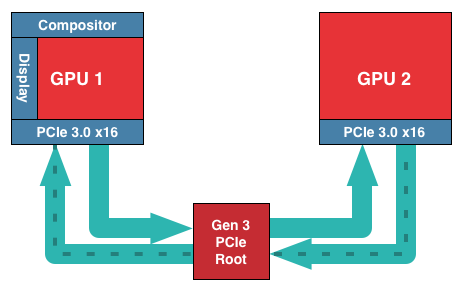
Of course by relying solely on the PCIe bus to transfer frames there are tradeoffs to be made, both for the better and for the worse. The benefits are of course the vast increase in memory bandwidth (PCIe 3.0 x16 has 16GB/sec available versus .9GB/sec for CFBI) not to mention allowing Crossfire to be implemented without those pesky Crossfire bridges. The downside to relying on the PCIe bus is that it’s not a dedicated, point-to-point connection between GPUs, and for that reason there will bandwidth contention, and the latency for using the PCIe bus will be higher than the CFBI. How much worse depends on the configuration; PCIe bridge chips for example can both improve and worsen latency depending on where in the chain the bridges and the GPUs are located, not to mention the generation and width of the PCIe link. But, as AMD tells us, any latency can be overcome by measuring it and thereby planning frame transfers around it to take the impact of latency into account.
Ultimately AMD’s goal with the XDMA engine is to make PCIe based Crossfire just as efficient, performant, and compatible as CFBI based Crossfire, and despite the initial concerns we had over the use of the PCIe bus, based on our test results AMD appears to have delivered on their promises.
The XDMA engine alone can’t eliminate the variation in frame times, but in its first implementation it’s already as good as CFBI in single monitor setups, and being free of the Eyefinity/4K frame pacing issues that still plague CFBI, is nothing short of a massive improvement over CFBI in those scenarios. True to their promises, AMD has delivered a PCie based Crossfire implementation that incurs no performance penalty versus CFBI, and on the whole fully and sufficiently resolves AMD’s outstanding frame pacing issues. The downside of course is that XDMA won’t help the 280X or other pre-GCN 1.1 cards, but at the very least going forward AMD finally has demonstrated that they have frame pacing fully under control.
On a side note, looking at our results it’s interesting to see that despite the general reuse of frame pacing algorithms, the XDMA Crossfire implementation doesn’t exhibit any of the distinct frame time plateaus that the CFBI implementation does. The plateaus were more an interesting artifact than a problem, but it does mean that AMD’s XDMA Crossfire implementation is much more “organic” like NVIDIA’s, rather than strictly enforcing a minimum frame time as appeared to be the case with CFBI.


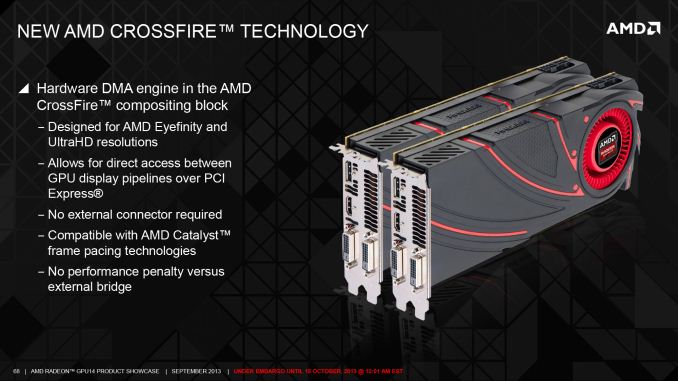
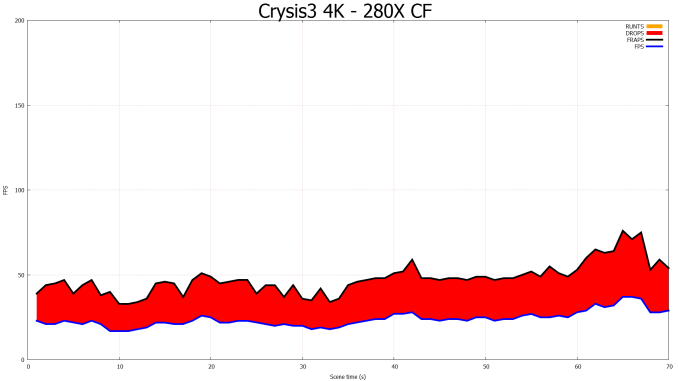
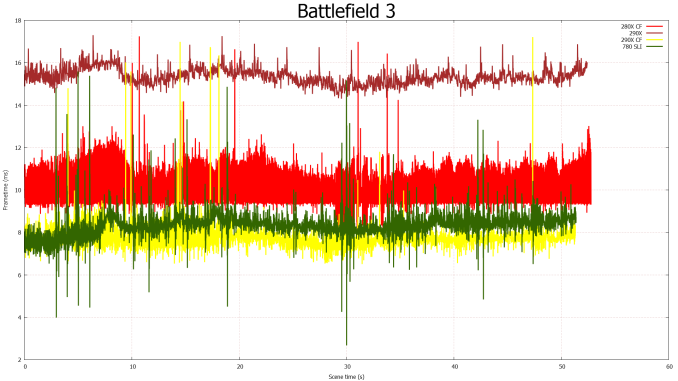
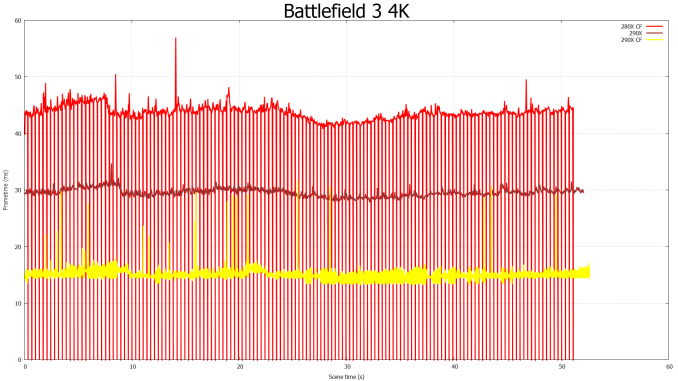








396 Comments
View All Comments
pattycake0147 - Friday, October 25, 2013 - link
Nope piroroadkill is spot on with speaking his opinion. Anand continually asks for reader feedback, and he's doing just that.The rate at which this article is being finished is piss poor. Ryan said it would be finished in the morning the day of posting which meant in the next 12 hr or so. The main explanatory pages took about 24 hr to be completely fleshed out, and the graphs still don't have any text explaining the trends in performance. I actually value the author's commentary more than the graphs, and looking through a review which is incomplete over 36 hr after posting is much below Anandtech standards.
I hate to bring it up because I like reading the vast majority of content on Anandtech regardless of market or complany, but I firmly believe piroroadkill is correct in saying that a new Apple product would have had a complete and thorough review shortly after NDA was lifted.
HisDivineOrder - Friday, October 25, 2013 - link
He had three R9 290X's in one system. Crossing his chest, he took out his third and slid its PCIe into the test bed. Immediately, the room began to darken and a voice spoketh, "You dare install THREE R9 290X's into one system! You hath incurred the wrath of The Fixer, demon lord of the 9.5th circle of hell! Prepare for the doooooom!"Then the system erupted into flames, exploding outward with rapid napalm-like flames that sent him screaming out the door. Within seconds, the entire building was burning and within minutes there was nothing left but ashes and regrets.
Ever since, he has been locked away in a mental health ward, scribbling on a notepad, "Crossfire," over and over. Some say on the darkest nights, he even dares to whisper a single phrase, "Three-way."
B3an - Saturday, October 26, 2013 - link
LOL!Ryan Smith - Monday, October 28, 2013 - link
Hahaha!Thanks man, I needed that.
yacoub35 - Friday, October 25, 2013 - link
It's a bit silly to list the 7970 as $549 when the truth is they can be had for as little as $200. And they're easily the best deal for a GPU these days.yacoub35 - Friday, October 25, 2013 - link
To clarify: A marketing piece lists "Launch prices", a proper review compares real-world prices.yacoub35 - Friday, October 25, 2013 - link
So double the ROPs on a new architecture and an extra GB of faster GDDDR results in maybe 10-20 more frames than a 7970GE at the resolution most of us run (1920x). Somehow I don't think that's worth twice the price, let alone the full $549 for someone who already owns a 7970.Jumangi - Friday, October 25, 2013 - link
Only a clueless noob with too much money in their pocket would buy a 290x if they are running at 1920 resolution.kyuu - Friday, October 25, 2013 - link
If you're just looking to game at high details on a single 1080p monitor, then no, the 290X isn't interesting as you're spending a lot of money for power you don't need. If you're gaming at 1440p or higher and/or using Eyefinity, then it's a different story.Hulk - Friday, October 25, 2013 - link
I just wanted to thank Ryan for getting up the charts before the rest of the article. We could have either waited for the entire article or gotten the performance charts as soon as you completed them and then the text later. Thanks for thinking of us and not holding back the performance data until the article was finished. It's exactly that type of thinking that makes this site the best. I can imagine you starting to work on the text and thinking, "You know what? I have the performance data so why don't I post it instead of holding it back until the entire article is finished."Well done as usual.